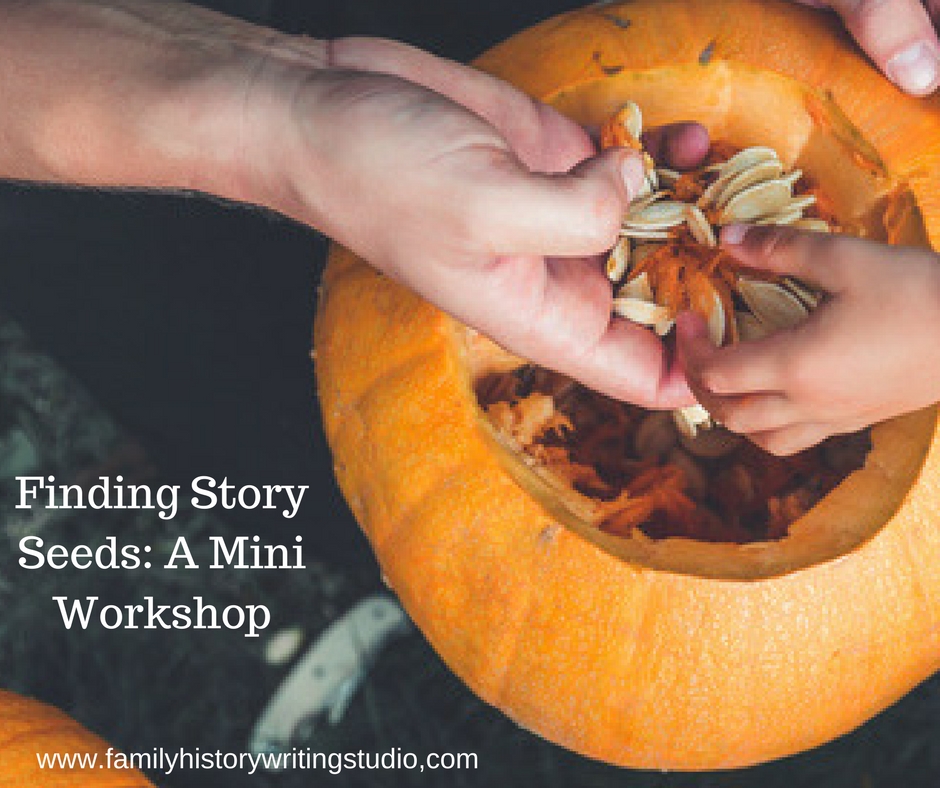Related Post

Finding Story Seeds: A Mini-WorkshopFinding Story Seeds: A Mini-Workshop
All too often when we think about writing our family history stories, we contemplate writing about those big story ideas. We want to write an ancestor’s life story from birth to death. We think about writing our family history from as far back as we have researched to present day. These are pumpkins. Gigantic pumpkins.
Your family history might very well be an inspiring and insightful story. But when writing your family history, you don’t always have to go big. Sometimes there are little seeds of stories buried within your research. I love those stories because they zoom in and show our ancestors in their most personal moments. These intimate moments will resonate with your readers.
Often, we have these pumpkin size ideas. Pumpkin ideas are cumbersome and hard to carry. They tend to wear us down. They are overwhelming. When you write about huge topics, you can tire out and lose interest. Huge topics can also be challenging to write, with so many aspects to consider. It’s more fun to dig out the seeds than carrying around a big awkward pumpkin.
LET’S CARVE UP OUR PUMPKIN IDEA AND FIND THE SEEDS
For example, my mother’s life story is a pumpkin size idea. It’s a huge pumpkin with over 85 years of life to write about. Even if I break her life story down into subtopics, they can still be significant. Watch me do this with my mother. I jot down pumpkin-sized ideas in my notebook.
They might look something like this:
- Growing up in Northern Ontario
- Working on the Tobacco Farms in Southern Ontario
- Married life and raising children
In my notebook, I have carved up my pumpkin and listed all sorts of things that were interesting about my mother’s life, as you can see above.
Now that I’ve carved up my pumpkin, I begin to see the seeds and start to pull out those seeds.
- Her first job cooking and cleaning for a family
- The day she left home
- Blueberry picking trips
- Giving her baby sister her first bath
- Cooking meals at the Poorhouse
Ohhhh, see that!? Now, these moments are starting to sound more like stories, and less like topics. You saw how I did that, right? Finding my seed ideas inside that big pumpkin of a life story.
Now, you may already have ideas that are somewhat specific. Maybe you’ve carved your pumpkin already instead of leaving it whole. But I challenge you to zoom in and pull out those small seeds.
NOW IT’S YOUR TURN TO FIND SEED IDEAS
Grab your writing notebook, and identify an ancestor you want to write about. This is your pumpkin idea.
Next, create subtopics, carve up that pumpkin, usually around time periods or significant events in your ancestor’s life. They may look like this:
- marriage
- immigration
- buying land
- going to school
- career
Next, take that carved pumpkin and pull out the seeds, those little ideas within those topics.
For example,
Immigration
- Buying the ticket
- Seeing North America from the ship for the first time.
Job
- First day on the job
- Receiving an award
- Last day on the job
Marriage
- A funny event at the ceremony.
- First date
- Marriage proposal
Seed ideas are usually memorable moments in a person’s life, but they also can trigger random specific moments in their life that can hold significant meaning.
If you’ve been struggling to get your family history stories out, I’d suggest it could be that you’re carrying too large of an idea. Every time you write, remember to zoom into your ideas, carve up the pumpkin and start to pull out those small seeds. A seed idea is quite fun and manageable to write about!
Go on, dig out those seeds and start writing.

When Another Necktie Just Won’t Do! (Gift Idea)When Another Necktie Just Won’t Do! (Gift Idea)
This Father’s Day the best gift you could offer your father is the commitment to write his story.
Ok, before I hear a big collective sigh out there because you thought you were going to get way with a golf shirt again this year, let me explain. It doesn’t have to be big and take you the next five years. You don’t have to have it completed for Father’s Day. In fact, I’ve done a lot of the work for you. I designed a beautiful gift certificate, Father’s Day Gift Certificate, you can download and give to him, and I’ve prepared 11 questions that will help you to get the information you need to start writing. These questions are built around the necessary elements you need to create a great story.
These 11 questions will help you to interview your father while at the same time focusing in on the key elements needed to tell an entertaining, compelling story.
Set up some interviews, maybe a couple of hours each week and ask the questions. You could do it in one sitting but don’t wear the poor man out. Each of these questions will help you to set up a story, with a setting, a goal, conflict, obstacles, motivation, and theme, all key to writing a compelling and engaging story. I’ve noted beside each question what story element they may contribute to.
Story Questions
1. Start with the basics – if you don’t already know them, where he was born, lived, went to school, married. Your genealogists you know the stuff I’m talking about. You most likely have all this information, but it never hurts to confirm it again. Setting
2. Get some accurate descriptions of the principal places in his life. What did his house look like? His bedroom, his place of work, etc.? Get very detailed. What was on the walls, the furniture? Use your five senses, how did sound, smell, touch, see and taste? Setting
3. What was life like growing up for him? Was it carefree? Stressful? What kinds of things influenced his growing up years? Money, War, Depression, Friends. Social History
4. Who were the key people in his life besides his parents? Individuals who supported him and influenced him along the way. Main Characters
5. His thoughts on his parents. How were they as parents, what did they teach him? What didn’t they teach him? What kind of parents were they, strict, lenient, fair? What did he learn from them? Does he emulate them? How did he hope not to be like them? What skills, morals, and values did they stress on him? Backstory/conflict/motivation
6. What were your father’s dreams and aspirations? What did he want to achieve in his life? Did he or didn’t he achieve those goals and why? Goals
7. What obstacles did he have to overcome to meet his goals? At any point did he change his path on his way to his goal or change his target completely somewhere along the way. Obstacles
8. Did anyone in his life object or hold him back from his goals? Antagonist/Conflict
9. What motivated him in his life and goals? Did he fear not meeting these goals? Why? Motivation
10. What life lesson would your father like to pass on to his descendants? Theme
11. How have his choices changed him and his outlook on life and what he wants for his children and grandchildren? Inner Journey
With these 11 questions in hand, you now have the key ingredients of a great story. Not a chronological tale of a life but a story with depth, meaning and purpose. A story shaped around goals and aspirations that were met with conflicts and obstacles.
Use Workbook #3 Finding the Story, Plotting Your Ancestor’s Journey to structure your answers into a compelling story format. Add some pictures and you will have a nice little book in honour of your father. You’ll likely move up to favourite child status very quickly.
Take advantage of our June Special. Get Workbooks, 1, 2, and 3 in downloadable PDF format for $17.00.
Consider interviewing your father using the above questions and then joining us this fall for our online course, Plotting a Family History Story. Now open for registration. Limited spaces.